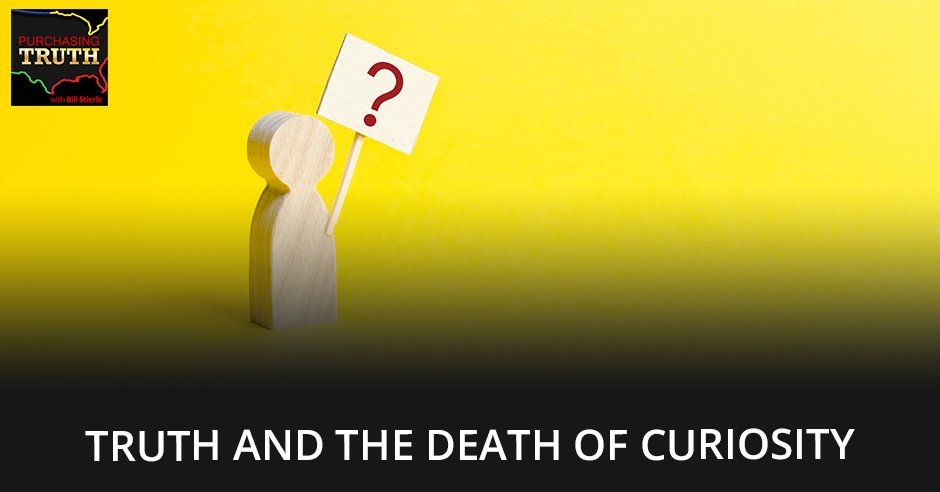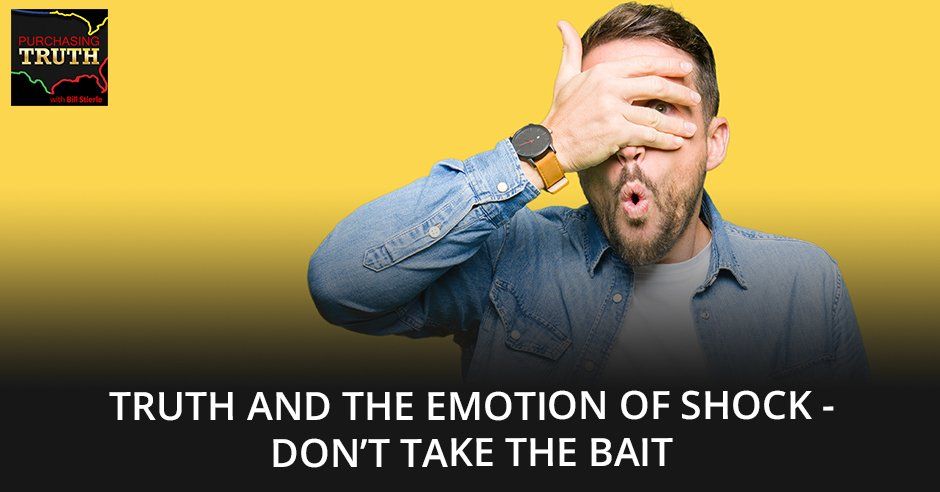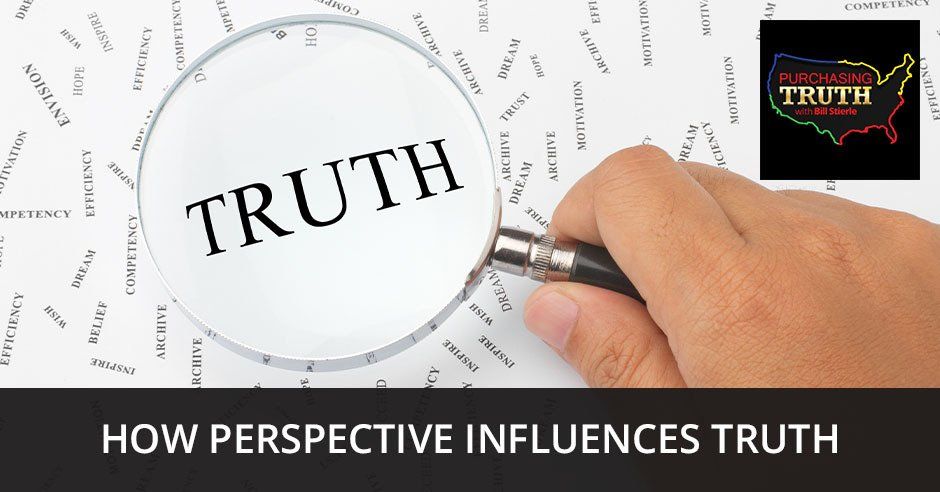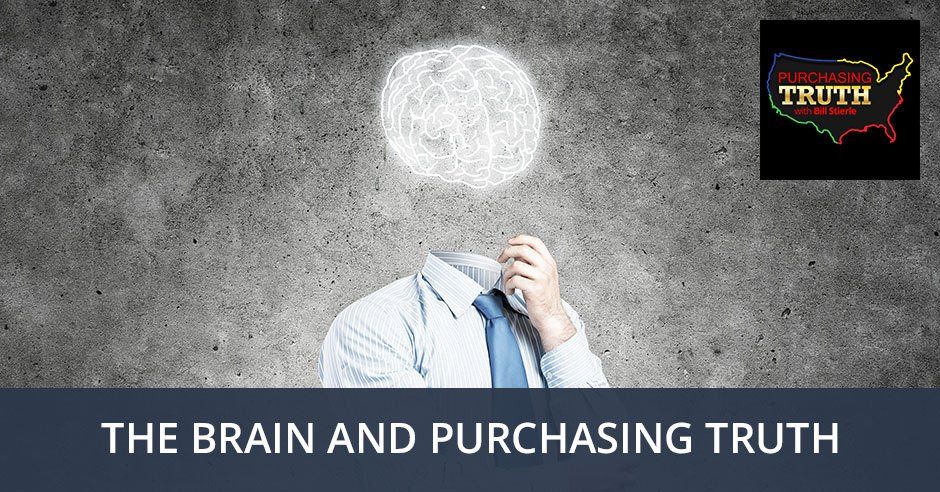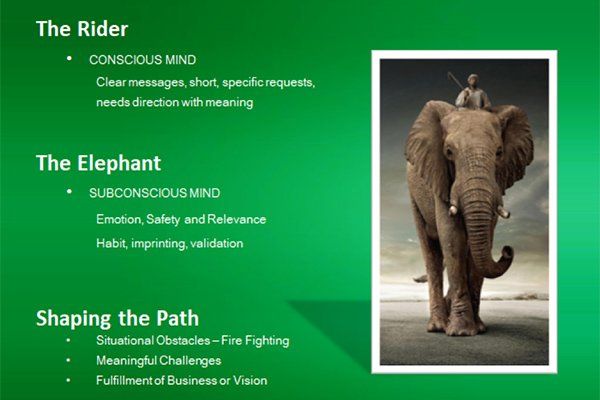The Brain And Purchasing Truth
Subscribe Today!
Making wise decisions for ourselves has become a difficult ordeal these days especially with all the distractions seemingly influencing us. In this episode, Bill Stierle and Tom present some very interesting facts about how our brains are bent to believe things that others want us to believe. Using the elephant metaphor, they open our eyes to how people of influence steer us towards their branding schemes. Using Donald Trump and Bill Clinton as examples, they discuss how the former is taking branding to a whole new level. Join Bill and Tom as they dive deeper and compare this manipulation to how socialism has been used as a tactic by the enemy and how our brains can be easily tapped.
---
Watch the episode here
One of the biggest challenges that human beings face is that we have this brain inside our head. It is very much like the metaphor of the picture of the elephant and the rider, the guy sitting on top with the stick. The problem is that when there’s messaging or when there’s a belief that takes place, it goes into our brain and it gets stored like the elephant into long-term memory. There’s no mistake that the elephant metaphor is going to work here very much because elephants don’t forget. That’s the whole idea of it. It’s got a long-term habit thing going and then there’s a little rider sitting on top here having a stick. He’s tapping the elephant on the left or the right to get them to go in a direction.
The front part of our brain is very much like that. This one part of the brain, if you tap it one way, it’ll go over here to do this but notice that you’ve got to do small taps to get it there. Micro-messages get the person to face or the elephant to face in the direction that they only want to see, not a full view, but just the direction they want to see. The rider is where the conscious mind sits. It’s our logical and rational mind and our future-oriented mind. All you’ve got to do is tap it in a specific way. It gets the elephant to go there and then the elephant develops a habit. There’s no greater example than the way Americans market to the consumers that buy their products. It’s small little messages tapped in the same direction until we get the habit or pattern set so that the product is known very well. The product has a belief structure that sits in it and the person purchases that thing.
Once the brand has a place in our head that’s in long-term memory, all I’ve got to do is say the word Cheerios and the brain immediately knows what the box looks like. It knows that it’s made out of wholesome oats and it’s good for the heart. Those are the messages that they have tapped our brains in. What winds up happening in messaging is the elephant hooks to emotion and safety and relevance and the habit is imprinted and then creates a validation. In the environment, you can see that if I tap this elephant enough in the direction for whatever term that I would like to not get people to like and set this next to this, what winds up happening is that all I got to do is talk about the term that nobody likes and then set the thing that I don’t want to take place next to that term. When the word, socialism, shows up, what has been successfully done is there’s been a confusion and a belief and a judgment that the concept of socialism is bad because Socialism is what the communists used. What other very strict constrictive socialist countries do is they cramped down on things like freedoms and expressions because that now is next to democrat. Does that make some sense?
It makes complete sense. It’s interesting what you’re saying is that in general, in America, in the marketing world, this technique is done to establish an impression in people’s minds of a product. That same technique is used by politicians either to paint the picture they want you to see about themselves, to establish a belief or to establish a belief against their opponent in a negative way.
All of a sudden, if I want to brand or market and print something, whether you are a person that’s for Trump or not for Trump, one of the things that he successfully did was brand all of his opponents. Whether they liked it or not, he branded them and they didn’t know how to combat the messaging because his message got amplified. It created an elephant response that was disguised. “Was there truth in some of the things that he was talking about?” “Yes. There are a lot of noes but there are a lot of yeses too.” There were mistakes with this and there were mistakes with that because human beings make mistakes. You can find a mistake that someone makes and all of a sudden, you’re in big trouble.
Didn’t Trump take this to a new level? He may have raised it to a new level, but he may have lowered it to a new level, too, in reality. The labels he established for his opponents like Little Marco, Lyin’ Ted and Crooked Hillary, these are the things that he repeated until people believed it.
It’s the same messaging and whether there was collusion or no collusion, that’s not important right now. What’s important is when a person repeats a message over and over again, it is a belief, habit and message based on what the rider and the elephant want to engage in. An article that is a fair assessment, like the one you shared with me is that people don’t like to hear that they’re falling into those categories because their elephant brain showed them that your identity is in with this person. You voted for this person, why don’t we build the wall as this person wants? These other people are obstructionists but meanwhile, that’s not the experience of an obstruction. An obstruction is an experience of one side not letting the other side to do things. That’s not what’s been happening.
That’s something I’ve been thinking about a lot lately. Conceptually, we’re foreshadowing some things we may take some deeper dives into. It was pointed out to me. We should establish and agree that every article that’s written is probably going to be written by somebody that has some inherent biases in the writer. They may try to be writing a neutral story or telling something from a neutral perspective, but there may be some biases there. It seems even when there’s an article that attempts to be looking at the big picture and being objective, if it ends up holding up a mirror to people who have these established beliefs, those people that have those beliefs don’t like it. They tend to view that article as extremely biased.
They’re going to search for vocabulary in the article that has voices of judgment or a place of explanation or understanding. How did this person get here? This is the author’s belief about how this has shown up, but the readers are not reading for perspective. They’re reading for validation because that’s what the elephant reads. The elephant reads from validation. It doesn’t read from here’s how I can learn, grow and get better. Here’s how to deal with the problem and instead, it’s like, “I don’t know what to do but my belief is locked in a direction.” The elephant gets into a little bit of trouble here because when a poacher wants to poach an elephant, they look for the tracks that elephant has done for many years.
They line themselves up on the track and go, “We know exactly where this elephant is walking because of their habit, their tribe and their thing. This is the time of year that they migrate from this place to this place because of the rain. The elephant’s been doing it for years.” The elephant’s frontal cortex is not as strong as the habit part of their brain. They have a long-term memory, whereas the front part of our brain scrambles us and welcome to the world of dementia. You don’t know what your next thought is and you are disconnected from the emotional part of your brain. All of a sudden, there’s this linkage of stuff that your front part of the brain has been trying to tap down and try not to deal with.
There are some neurological and physiological problems that are showing up. Go to the extreme. An extreme is a cult leader, somebody that leads to meet their needs at the expense of others. They’re trying to get either recognition or respect or self-worth or even the identity of the cult or the stability or certainty of people around them to get a connection. It’s problematic because their messaging is going to be in alignment with that. How can I create greater enrollment, greater loyalty and greater consistency in? The consistency of the message is very important. In our changing world though, a consistent message is not the speed our world is moving in right now. We are not moving in a consistent, stable way. If you’d take a look at the speeches of Ronald Reagan when he first started politics, when he was getting into the white house and even when he left, all of the speeches have this similar consistent belief structure and stability to them.
What winds up happening is the people that get enrolled that he has and will do these things for us are going to think he’s the greatest person ever. Why don’t we ask his son? His son doesn’t think that way and he goes, “My dad had some pretty good flaws.
By the way, those flaws played out in the way he led the country.” He is a humanist. A validated brain, one that is looking to prove what their initial belief about something is going to be where the brain goes. The third option in this is, how do we shape the path? If we look at things like restoration or messaging from politicians that are interested in a balanced narrative versus an exclusionary narrative. The exclusionary narrative is I want my side to occupy the space in the future and I’m going to be known as that.
Americans market to consumers to buy their products through small messages tapped in the same direction until the product is well known.
CLICK TO TWEET
You’re trying to meet your recognition and acknowledgment about the way you would like to see America as a conservative America. Therefore, you’re going to promote judges that believe and have the same elephant brain that you do. These are the ones that are fighting for this cause because it’s going to help the people that put me here. It’s going to help my belief structure. It’s going to be the way I see the world and I might even bend or break the rules in order to get my belief structure to take hold.
That’s an interesting point you made, “I might bend my belief structures.” I have been thinking back on some current examples of this, but you have to compare them to a past example to see them. I want to share one with you and see what you think. We have a president in office who has been divorced twice. There is plenty of evidence that he has had extramarital affairs and then you’re going to get into the belief structures of, “Did he really or did he really not?” It seems we have some pretty clear evidence with checks he’s paid and photos that have been taken. We also have his own words on this Access Hollywood tape about what he thought about women. There’s a lot of actual evidence. I find it interesting that people that are supporters of Trump are supporting him despite many of their own personal values and beliefs about what you should be as a good human being on this earth.
They can compartmentalize and put those aside because they align with him on other issues that are important to him. Before you jump in, I want to contrast that. I remember back in the lead up to the campaign in 1992 with Bill Clinton running against George W. Bush. At that time, I had the first job I ever had as an adult. I was in South Carolina, a very conservative area. There were co-workers that were absolutely shocked and in disbelief about how anybody who had any moral character would ever consider voting for Bill Clinton because there were allegations that he had had extramarital affairs. I don’t know how much proof there was but certainly, some people came out and were talking about it. They would be absolutely be damned if they would vote for someone like that. How could anybody elect someone like that into the White House? Look what has happened in the 2016 elections, electing someone to office who admitted on that same level? It seems that people bend the truth or certainly changed their perspective and their feelings on things, depending on whether they’re aligned in other ways.
The identity is a big part of it. I am identifying with this person. I am identifying with this group. I’m that identifying with this religious group or belief structures. The challenge is that the brain is going to want to stay with the identity and be engaged with the identity instead of what the broader perspective is. They’re going to let go of certain things. That’s a big thing too.
You talk about the words that establish the belief structure, the words that are tactically used.
The main thing is to get a hold of what the person’s identity is, they’re going to submit their strong beliefs about fiscal responsibility. Their strong beliefs around the stuff you mentioned about women and sexuality. They’re going to set aside because my identity is with this person now. Instead of, “Here are my core beliefs that are fundamentally against what this person has done, said or is acting like.” It’s only the folks that have a relationship with their rider and their elephant that they can take the elephant in different directions. For example, the CIA Director Brennan or some of these other well-known Republicans like Steele and all these different folks that are going, “He’s is elected but he’s not our guy. He is not a part of the Republican value sets that we’re looking to get done. We know we’ve elected him. We know that he’s in there, but he’s not our guy.”
They’ve tapped their elephant away from that and they had enough flexibility to move in the direction and their brain going like, “These are against for him to run up the debt like this. For him to give them money to the military that they didn’t want, the contractors and the companies and the service providers most certainly took it and they figured out a way to spend the money that was there.” It’s disheartening, but this is the way the relationship of the brain works with the various different messages. There’s not a lot of time that people have to see the full picture of what’s happening to them with the micro messages. They got to pay their bills. They got to do their tax. They got to deal with car stuff and school stuff with their kids. They’re trying to create some relaxation and all they have time for is a couple of little snippets of news or snippets of late-night TV or snippets of conversations. This is when it gets really troublesome. All they’re doing is validating their current beliefs. They’re not listening to somebody compassionately and empathetically to say the following sentence. If you said the sentence, “Build the wall,” watch what I say next. Could you be a little scared and worried and you want protection in America? You want some safety, is that correct?
Absolutely.
It’s important for safety to take place and to keep people that aren’t in our country not to come here to get what we would like, what we have or stay and work out their lives in a different country because they weren’t born here. Is that correct?
Yes.
You see the identity of an American as somebody that looks like the people that you know in your community, not the new people that like to come here. Is that correct?
Yes.
All of this is empathetic and compassionate to the person’s point of view. Their elephant is not going to step on me or charge me because it’s true from their belief structure. It’s also true from their worries and concerns based on the messages that they’ve been fed and the repetition of those messages. There is a huge reason why the immigration issue has not been solved from Reagan all the way to now.
What is that reason?
It can be a consistent stick to tap the various different bases of belief structures. It can be tapped one way or another and all that’s got to be done is to tap somewhere between 5% to 10% of the population. You get them tapped over in the one direction and then you get in and your group is elected.
It sounds like you’re coming out and saying that the reason that whatever the immigration issues are that need to be resolved, improved or changed in any way have not been tackled tremendously. It’s a tool that people use to get elected and it’s too important to maintain it that way.
It’s too important to solve it because then you’ve got to find out a new thing because Reagan did do the amnesty. He didn’t say, “You all got here. A lot of you got here illegally. We’re going to make you all citizens now.” They didn’t fix it by doing that. They solved it and once they solved it, Clinton got elected. They had nothing to run on because they’re already in. We already fixed that. We do that with Reagan. We’ve got that amnesty thing and they never rewrote the rules to do it to really fix it. They couldn’t handle the volume and they weren’t focused on how to deal with populations and the movement of populations. Who wants to live in a war-torn country? Who wants to live in a place that policemen don’t stay in and provide the level of safety and protection for the people around them? They’d rather come to a place that there’s not a gunshot every night. “We woke up this morning and Joe got killed last night. Sally got killed yesterday or someone they know just died.” Who wants to live in that country? They were getting threatened because the violence is escalating. Not to say anything about our part in that, which is a big part of other societal problems that the different countries have.
You’d talked about the middle that can be swung one way or the other by tapping that side of the brain. The term that is coming up in my brain is Reagan Democrats. There was a whole group of people that must have been moved in that direction based on a belief that was tapped into.
They didn’t necessarily like the holistic and inclusive worldview that Jimmy Carter was bringing forward and say, “If we’re going to face the world’s problems and if we’re going to be the world leader, here are some things that we need to do.” All you’ve got to do is get the cowboy guy to come in that was literally a Hollywood cowboy actor. You’ve got him to come in and that is tapping into the belief structure of the past. “Remember how good it was when Cowboys were there. They were independent. They got to have their own ranch. They had their own cattle. They made a living.” It’s like, “Have you ever been on a horse? Have you ever wrestled cattle?” That is all as romantic as you’re making it right now, but it’s a simpler time. The elephant’s brain remembers that.
Here’s something, Tom. I think that’s going to freak you out a little bit. One of the things that I did in my slide deck on beliefs is I put in slides of dangerous animals. There’s a spider and there’s an alligator. All of them are in the attack and/or the things of the spider going into somebody’s hand. They’re strongly energetically visual of you as a human being is going to get bit by this thing even if it’s on the screen. Here’s the weird part about it is that the audience starts to sense that it’s coming. They start to sense that the slide is coming.
There’s a group of people that are sensitive in that way. They can see things coming. They’re a little more future-oriented. When that slide shows up, I’ve had people leave the room because they have preemptively, energetically figured out that the slide was coming. They picked it up because some people are very sensitive. Not everybody is sensitive but some people are. The weird part about that is that you don’t have to do much to move the elephant in the direction that you would like it to move, but you have to be consistent with it and stay with it. One of the biggest appeals for Bernie Sanders is he’s been consistent on and he has been stable on the wealth part, the college part and the healthcare part. Since he’s been tapping that elephant, every one of those folks has to have an answer for that.
The only problem with everybody else that is looking to contribute to the new government that might be coming in is they haven’t been as long at it as he has. They haven’t had the level of conviction and the engagement of that is so important. Who else has been there for a long time? Joe Biden has been there for a long time. You pick the safe guy and barely click it down the road a little bit or has the messaging of the elephant move long enough and have been tapping enough to say, “This is how Americans are going to care for their people from here on out, the way the top industrial countries do.” This is how the top industrial countries do it and America is going to get into that game. We’re not going to get into the competitive game regarding medicine. We’re going to get into the collaborative game regarding medicine. We’re going to all get there inside our group. We’re all getting there because we all live here.
This explains why, even though these two gentlemen you mentioned are among the oldest candidates ever to run for office, it is why they’re getting the most money raised. There’s the most interest around them because people’s elephant brains are comfortable with and there are beliefs that they’ve been established that they can count on.
There’s no mistake on that. If I don’t wake up every day and hear that Trump has fired someone, I’ll think something’s wrong.
Something’s wrong if he doesn’t fire someone. He has spent his entire life and his brain has been cultured to in his show to be really good at firing people. Every show he fires, everybody until the last person that’s one, “You’re fired.” If he’s going to fire somebody tomorrow, why is that a surprise? It’s knowing what you’re getting, but also knowing that the elephant and the rider have been moving in a particular direction for a long time. It shows a sense of decisiveness, but it doesn’t meet the need for stability, which is one of the primary needs that the government is supposed to meet for the people. Stabilize us by putting these infrastructures in and executing these laws so that we are stable, so that we have the protection we would like and we can be efficient and we don’t have to be afraid every day. My brain is already ready for who’s going to get fired tomorrow because this is a hallmark of his job in the past. He fires people that don’t fit with the messaging or the thing he would like to do. He’s done that his whole life. Why is this a surprise?
Clearly, there’s been a new normal that’s been established in this current administration. Not just that kind of expectation, but also what the fact-checkers point out on a daily basis. How many actual lies are in every tweet, every speech and every interview on television by the President? That also has to be part of why at least half of America is so perplexed.
That’s the way to think about it. Confusion is a very important tool to keep the elephant into a compliance habitual way. If you keep them confused, they’ll fall back to the habit. They won’t look for growth or change or even question their own belief structures. “I’m not going to question the belief structure because this teacher told me this, that’s what my parents modeled, my minister said it. I am giving a lot of respect and credibility to the newscaster because I can’t talk the way a newscaster talks. I’m going to pay attention to their messages because I can’t do their job. Therefore, they’re better than me.” Instead of the reality, “Here’s a human being giving me a message. I need to do a better job of seeing if I’m going to take it or leave it.” That’s really problematic.
Roger Stone said this very clearly on national TV. He goes, “I’m a student of Edward Bernays’, the book of Propaganda. I know how to create messages that people get ahold of and that are engaging for people to believe in.” I’m listening to him and I’m going, “He’s telling the trick of a book that has been used at the end of World War II to get Americans to believe in the 1950s version of America. That was a book that was propagandized.” Here’s the wife at home. Here’s the husband doing the work. Here are the kids. Here’s the suburb. This is the way America is to look.
That was the ‘40s, ‘50s mantra. It was like, “This is the way America is supposed to look.” They put those pictures and they propagandize it out. At the same time, it was the same book used by Goebbels for Nazi Germany. This is the way Germans look. Germans are all going to get a house. They’re all going to get their own Volkswagen. They’re all going to get this vacation thing. You’re all going to get this promise. Propaganda is not a bad word from the standpoint of the original definition, which is to propagate an idea of the value you want to make seen or known to the world.
It came out of the Catholic church. The Italian word for propaganda is we’re going to propagate the faith. Because marketing has got a hold of this thing and because industry leaders have got a hold of this thing, it’s like, “How well do you saturate things to get the message out?” “I don’t want to talk to doctors anymore. I want to saturate and talk to the person that is the patient.” We have ads for every single medicine that comes out. They’re not propagating. They’re not selling to the doctor. They want the patient to go to the doctor and say, “I saw this Latuda thing. Would that be good for me? I saw this medicine. It looks like I’m going to vomit, but it’s better than this rash on my skin.”
I’m always shocked with all the disclaimers when you see those. Listen to those commercials on the radio or see them on television. Are people listening to this? Would they ever take it if they understood all this? You’re right, that whole industry is reaching out to the end consumer, pulling them into the doctor to request for the medication.
Small messages to get the rider of this elephant to tap the elephant in the direction that they would like the person to go so that they can embrace the message.
Bill, as I’m listening to this and learning, I’m getting a little depressed. Does this mean that there is no truth to anything? Is it just our belief systems? I would imagine there has to be truth somewhere deep down.
There is. As we wrap up this portion, we need to stand for, “What does mutual respect look like? What does a perspective around the truth? What does fairness look like? What does growth look like from an educational standpoint? How do we grow our people to get these higher-paying jobs?” A lot of them are under-skilled and they are burdened with debt before they can get the next level of skill they need. They aren’t going to do that and go into further debt when they’ve got so much debt already. Those are a few things to talk about as we continue down this path regarding truth and be able to embrace this new way of thinking about this. This has been a great conversation.
Thank you so much, Bill.
There is more to come. Until next time. Thanks, Tom.
Important Links:
- Propaganda
- https://www.HBO.com/real-time-with-bill-maher
- https://www.YouTube.com/channel/UCy6kyFxaMqGtpE3pQTflK8A
Love the show? Subscribe, rate, review, and share!
